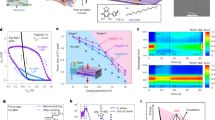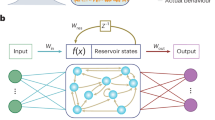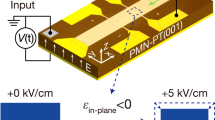Abstract
Neuromorphic computing based on emerging devices could overcome the von Neumann bottleneck—the restriction created by having to transfer data between memory and processing units—and help deliver energy-efficient data processing. The van der Waals semiconductor α-phase indium selenide (α-In2Se3) offers ferroelectric, optoelectronic and semiconducting properties and is potentially an ideal substrate for information processing, but its physical properties are not well exploited. Here we report an optoelectronic synapse that is based on α-In2Se3 and has controllable temporal dynamics under electrical and optical stimuli. Tight coupling between ferroelectric and optoelectronic processes in the synapse can be used to realize heterosynaptic plasticity, with relaxation timescales that are tunable via light intensity or back-gate voltage. We use the synapses to create a multimode reservoir computing system with adjustable nonlinear transformation and multisensory fusion, which is demonstrated using a multimode handwritten digit-recognition task and a QR code recognition task. We also create a multiscale reservoir computing system via the tunable relaxation timescale of the α-In2Se3 synapse, which is tested using a temporal signal prediction task.
This is a preview of subscription content, access via your institution
Access options
Access Nature and 54 other Nature Portfolio journals
Get Nature+, our best-value online-access subscription
$29.99 / 30 days
cancel any time
Subscribe to this journal
Receive 12 digital issues and online access to articles
$119.00 per year
only $9.92 per issue
Buy this article
- Purchase on Springer Link
- Instant access to full article PDF
Prices may be subject to local taxes which are calculated during checkout






Similar content being viewed by others
Data availability
The data that support the findings of this study are available on Zenodo (https://zenodo.org/record/7120149#.YzRSL0xBw2w). All other data are available from the corresponding author upon reasonable request.
Code availability
The codes used for simulation and data plotting are available from the corresponding authors upon reasonable request.
References
Zheng, Z. et al. Unconventional ferroelectricity in moiré heterostructures. Nature 588, 71–76 (2020).
Fei, Z. et al. Ferroelectric switching of a two-dimensional metal. Nature 560, 336–339 (2018).
Chang, K. et al. Discovery of robust in-plane ferroelectricity in atomic-thick SnTe. Science 353, 274–278 (2016).
Higashitarumizu, N. et al. Purely in-plane ferroelectricity in monolayer SnS at room temperature. Nat. Commun. 11, 2428 (2020).
Yuan, S. et al. Room-temperature ferroelectricity in MoTe2 down to the atomic monolayer limit. Nat. Commun. 10, 1775 (2019).
Si, M. W. et al. A ferroelectric semiconductor field-effect transistor. Nat. Electron. 2, 580–586 (2019).
Wang, S. et al. Two-dimensional ferroelectric channel transistors integrating ultra-fast memory and neural computing. Nat. Commun. 12, 53 (2021).
Wu, J. et al. High tunnelling electroresistance in a ferroelectric van der Waals heterojunction via giant barrier height modulation. Nat. Electron. 3, 466–472 (2020).
Wang, L. et al. Exploring ferroelectric switching in α-In2Se3 for neuromorphic computing. Adv. Funct. Mater. 30, 2004609 (2020).
Ding, W. et al. Prediction of intrinsic two-dimensional ferroelectrics in In2Se3 and other III2-VI3 van der Waals materials. Nat. Commun. 8, 14956 (2017).
Zhou, Y. et al. Out-of-plane piezoelectricity and ferroelectricity in layered α-In2Se3 nanoflakes. Nano Lett. 17, 5508–5513 (2017).
Xue, F. et al. Room-temperature ferroelectricity in hexagonally layered α-In2Se3 nanoflakes down to the monolayer limit. Adv. Funct. Mater. 28, 1803738 (2018).
Xue, F. et al. Gate-tunable and multidirection-switchable memristive phenomena in a van der Waals ferroelectric. Adv. Mater. 31, 1901300 (2019).
Gabel, M. & Gu, Y. Understanding microscopic operating mechanisms of a van der Waals planar ferroelectric memristor. Adv. Funct. Mater. 31, 2009999 (2021).
Si, M. et al. Asymmetric metal/α-In2Se3/Si crossbar ferroelectric semiconductor junction. ACS Nano 15, 5689–5695 (2021).
Wan, S. et al. Nonvolatile ferroelectric memory effect in ultrathin α-In2Se3. Adv. Funct. Mater. 29, 1808606 (2019).
Xiao, J. et al. Intrinsic two-dimensional ferroelectricity with dipole locking. Phys. Rev. Lett. 120, 227601 (2018).
Cui, C. et al. Intercorrelated in-plane and out-of-plane ferroelectricity in ultrathin two-dimensional layered semiconductor In2Se3. Nano Lett. 18, 1253–1258 (2018).
Island, J. O., Blanter, S. I., Buscema, M., van der Zant, H. S. & Castellanos-Gomez, A. Gate controlled photocurrent generation mechanisms in high-gain In2Se3 phototransistors. Nano Lett. 15, 7853–7858 (2015).
Jacobs-Gedrim, R. B. et al. Extraordinary photoresponse in two-dimensional In2Se3 nanosheets. ACS Nano 8, 514–521 (2014).
Zhai, T. et al. Fabrication of high-quality In2Se3 nanowire arrays toward high-performance visible-light photodetectors. ACS Nano 4, 1596–1602 (2010).
Xue, F. et al. Optoelectronic ferroelectric domain‐wall memories made from a single van der Waals ferroelectric. Adv. Funct. Mater. 30, 2004206 (2020).
Markovic, D., Mizrahi, A., Querlioz, D. & Grollier, J. Physics for neuromorphic computing. Nat. Rev. Phys. 2, 499–510 (2020).
Duan, Q. et al. Spiking neurons with spatiotemporal dynamics and gain modulation for monolithically integrated memristive neural networks. Nat. Commun. 11, 3399 (2020).
Zhou, F. et al. Optoelectronic resistive random access memory for neuromorphic vision sensors. Nat. Nanotechnol. 14, 776–782 (2019).
Yang, K. et al. Transiently chaotic simulated annealing based on intrinsic nonlinearity of memristors for efficient solution of optimization problems. Sci. Adv. 6, eaba9901 (2020).
Sebastian, A., Le Gallo, M., Khaddam-Aljameh, R. & Eleftheriou, E. Memory devices and applications for in-memory computing. Nat. Nanotechnol. 15, 529–544 (2020).
Liu, C. et al. Two-dimensional materials for next-generation computing technologies. Nat. Nanotechnol. 15, 545–557 (2020).
Zhu, J. et al. Ion gated synaptic transistors based on 2D van der Waals crystals with tunable diffusive dynamics. Adv. Mater. 30, 1800195 (2018).
Tuma, T., Pantazi, A., Le Gallo, M., Sebastian, A. & Eleftheriou, E. Stochastic phase-change neurons. Nat. Nanotechnol. 11, 693–699 (2016).
Yang, Y. & Huang, R. Probing memristive switching in nanoionic devices. Nat. Electron. 1, 274–287 (2018).
Li, C. et al. Analogue signal and image processing with large memristor crossbars. Nat. Electron. 1, 52–59 (2018).
Chen, S. et al. Wafer-scale integration of two-dimensional materials in high-density memristive crossbar arrays for artificial neural networks. Nat. Electron. 3, 638–645 (2020).
Jaeger, H. The ‘Echo State’ Approach to Analysing and Training Recurrent Neural Networks—With an Erratum Note. Technical Report GMD Report 148 (German National Research Center for Information Technology, 2001).
Maass, W., Natschlager, T. & Markram, H. Real-time computing without stable states: a new framework for neural computation based on perturbations. Neural Comput. 14, 2531–2560 (2002).
Torrejon, J. et al. Neuromorphic computing with nanoscale spintronic oscillators. Nature 547, 428–431 (2017).
Moon, J. et al. Temporal data classification and forecasting using a memristor-based reservoir computing system. Nat. Electron. 2, 480–487 (2019).
Zhong, Y. et al. Dynamic memristor-based reservoir computing for high-efficiency temporal signal processing. Nat. Commun. 12, 408 (2021).
Du, C. et al. Reservoir computing using dynamic memristors for temporal information processing. Nat. Commun. 8, 2204 (2017).
Zhu, X., Wang, Q. & Lu, W. D. Memristor networks for real-time neural activity analysis. Nat. Commun. 11, 2439 (2020).
Sangwan, V. K. et al. Multi-terminal memtransistors from polycrystalline monolayer molybdenum disulfide. Nature 554, 500–504 (2018).
Wan, S. et al. Room-temperature ferroelectricity and a switchable diode effect in two-dimensional α-In2Se3 thin layers. Nanoscale 10, 14885–14892 (2018).
Liu, L. et al. Atomicaily resolving polymorphs and crystal structures of In2Se3. Chem. Mater. 31, 10143–10149 (2019).
Li, Y. et al. Orthogonal electric control of the out-of-plane field-effect in 2D ferroelectric α-In2Se3. Adv. Electron. Mater. 6, 2000061 (2020).
Xue, F. et al. Multidirection piezoelectricity in mono- and multilayered hexagonal α-In2Se3. ACS Nano 12, 4976–4983 (2018).
Ho, C.-H. et al. Surface oxide effect on optical sensing and photoelectric conversion of α-In2Se3 hexagonal microplates. ACS Appl. Mater. Interfaces 5, 2269–2277 (2013).
Wang, M. et al. Gesture recognition using a bioinspired learning architecture that integrates visual data with somatosensory data from stretchable sensors. Nat. Electron. 3, 563–570 (2020).
Liu, M. et al. A star-nose-like tactile-olfactory bionic sensing array for robust object recognition in non-visual environments. Nat. Commun. 13, 79 (2022).
Adelson, E. H., Anderson, C. H., Bergen, J. R., Burt, P. J. & Ogden, J. M. Pyramid methods in image processing. RCA Eng. 29, 33–41 (1984).
Mozer, M. C. Induction of multiscale temporal structure. Adv. Neural Inf. Process. Syst. 4, 275–282 (1992).
Hochreiter, S. & Schmidhuber, J. Long short-term memory. Neural Comput. 9, 1735–1780 (1997).
Schmichuber, J., Wierstra, D., Gagliolo, M. & Gomez, F. Training recurrent networks by Evolino. Neural Comput. 19, 757–779 (2007).
Otte, S. et al. Optimizing recurrent reservoirs with neuro-evolution. Neurocomputing 192, 128–138 (2016).
Acknowledgements
This work was supported by the National Key R&D Program of China (2017YFA0207600, to Y.Y.), the National Natural Science Foundation of China (61925401, to Y.Y.; 92064004, to Y.Y.; 61927901, to R.H.; 92164302, to Y.Y.), Project 2020BD010 was supported by the PKU-Baidu Fund and the 111 Project (B18001, to R.H.). Y.Y. acknowledges support from the Fok Ying-Tong Education Foundation and the Tencent Foundation through the XPLORER PRIZE. We acknowledge the Electron Microscopy Laboratory of Peking University, China for use of the Cs-corrected Titan Cubed Themis G2 300 transmission electron microscope.
Author information
Authors and Affiliations
Contributions
K.L. and Y.Y. designed the experiments. K.L. and L.B. fabricated the devices. K.L. performed PFM measurements. K.L., L.X., C.C. and Z.Y. performed electrical measurements. K.L. and T.Z. performed the simulations. K.L., B.D. and Y.Y. prepared the manuscript. Y.Y. and R.H. directed all the research and supervised the work. All authors analysed the results and implications and commented on the manuscript at all stages.
Corresponding authors
Ethics declarations
Competing interests
The authors declare no competing interests.
Peer review
Peer review information
Nature Electronics thanks Matthew Dale, Matthew Marinella and the other, anonymous, reviewer(s) for their contribution to the peer review of this work.
Additional information
Publisher’s note Springer Nature remains neutral with regard to jurisdictional claims in published maps and institutional affiliations.
Supplementary information
Supplementary Information
Supplementary Figs. 1–23, Notes 1–3, Table 1 and references 1–23.
Rights and permissions
Springer Nature or its licensor holds exclusive rights to this article under a publishing agreement with the author(s) or other rightsholder(s); author self-archiving of the accepted manuscript version of this article is solely governed by the terms of such publishing agreement and applicable law.
About this article
Cite this article
Liu, K., Zhang, T., Dang, B. et al. An optoelectronic synapse based on α-In2Se3 with controllable temporal dynamics for multimode and multiscale reservoir computing. Nat Electron 5, 761–773 (2022). https://doi.org/10.1038/s41928-022-00847-2
Received:
Accepted:
Published:
Issue Date:
DOI: https://doi.org/10.1038/s41928-022-00847-2
This article is cited by
-
Reconfigurable optoelectronic transistors for multimodal recognition
Nature Communications (2024)
-
Asymmetric conducting route and potential redistribution determine the polarization-dependent conductivity in layered ferroelectrics
Nature Nanotechnology (2024)
-
Physical reservoir computing with emerging electronics
Nature Electronics (2024)
-
Toward grouped-reservoir computing: organic neuromorphic vertical transistor with distributed reservoir states for efficient recognition and prediction
Nature Communications (2024)
-
VO2 memristor-based frequency converter with in-situ synthesize and mix for wireless internet-of-things
Nature Communications (2024)



